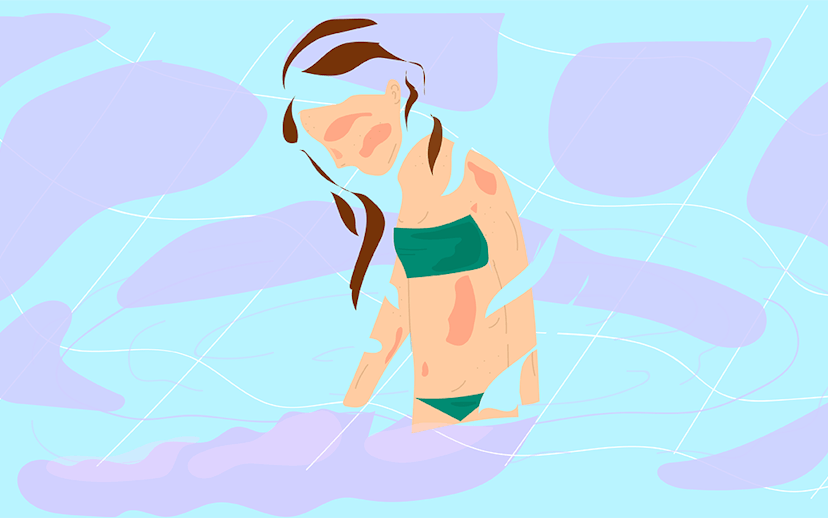
Beauty
How To Get Over Your Fear Of Swimming
Just in time for summer
In the summer, things like Stand-Up Paddleboarding, hanging out on the lake, chilling in the pool in those huge floating swans, and, of course, just playing in the ocean are common activities... But for someone who can't swim, these activities are actually dangerous—and so rightfully intimidating. But it's never too late to learn how to be comfortable in the water. So, if you’re sick of being the one always complaining of a cramp or finding excuses to stay in the kiddie pool rather than jumping off the deep end, we have some advice.
Focus on the Reality
“People focus on fear versus the action they want to take," says sports performance expert Traci Stanard, who is used to dealing with athletes facing performance anxiety. "So for a non-swimmer trying to get into the water, you need to pay attention to the water—what it looks like, what your body is aware of as you go into it—rather than our assumptions of what it’s going to feel like." Even the most seasoned triathletes can find themselves panicking when they hit the water on race day, so don't feel like you're hopeless if you get a little nervous.
Cool Your Jets
Most of the time, it’s not swimming itself that poses a problem, it’s a fear of even being in the water (especially in open bodies of water like lakes or the ocean!) “When you feel that panic reflex kicking in, ask yourself, Am I really not okay?” says Stanard. Pull yourself back to the present, and realize that it's really unlikely that you'd be attacked by sharks or jellyfish or... pool monsters.
Have a Plan
“Before you’re even near the water, think about what your limits are. Where do you want to get to? Maybe you want to just wade in, maybe you want to get up to your shoulders,” says Stanard. "Know what your goal is, and set that as your limit. If you end up going further, great, but having that safety zone set up beforehand can make it easier to get going.”
Learn to Float
Learn to float, and you’re basically a swimmer—or, at least, you’ll be able to hang out in a pool without a freakout. People have different natural floating abilities, but everyone can master the act of floating on your back or floating slightly submerged, gently treading water with your arms and legs. Practice both ways in the shallow end of your local pool, and your comfort level in the water will increase almost immediately. (Bring a friend to act as your spotter so you can focus on trying to float on your back or mostly submerged without fear of sinking under.)
Breaststroke Is the Easiest Option
Adult swimming lessons are readily available, as are tons of online tutorials and great books on the topic. “For different people, how to get started can be different,” says Suzanne Atkinson, MD. She's an endurance coach based in Pittsburgh and the co-founder of Fresh Freestyle, a program devoted to helping new and expert swimmers see real results—and she sees new swimmers coming in constantly. Some just want to make it across a pool without stopping, others are aiming for Ironman-distance triathlons, but getting started is always a challenge. If you’re really new to swimming, Atkinson recommends focusing on breaststroke, as it’s the most similar stroke to the doggy paddle you may have done as a kid, and requires much less energy and coordination than a freestyle stroke (what you see triathletes doing). Breaststroke also allows you to keep your head mostly above water (or entirely above, if you’re not ready to go under just yet), so it’s very beginner-friendly. If you prefer learning from an expert, call your local pool and ask if they have a recommendation for a coach willing to teach breaststroke.
Practice Putting Your Head Under Water While Standing
Before you hit the deep end, stick to the shallow end to practice getting your face wet, says Atkinson. This way, you’re completely in control of the situation and your panic reflexes won’t kick in—or if they do, you just have to plant your feet and stand up! Practice submerging your face and blowing bubbles through your nose (not through your mouth!). When you do start swimming, you’ll inhale when your head is up, and exhale through your nose when you submerge your face in order to move forward in a more efficient movement.
Skip Props in the Pool
Many new swimmers head to the pool and snag a kickboard, pull buoy, foam belt, and whatever other accessories are sitting around on the pool deck. But Atkinson says that’s going to make your learning process go much slower overall, even though it feels like you’re making progress. The hardest thing to learn in the pool is floating as you swim, and things like the belt or a kickboard give you a false sense of floatation without learning the skill. So while wearing a life vest is a must when you’re swimming in a lake or going out on a kayak as a new swimmer, in the pool, try to stay prop-free.
Take Your Time
Most of your friends who seem like mer-people when they get near a lake have been swimming since early childhood, so don’t stress if you didn’t have the kind of upbringing that let you embrace your inner Ariel. “People put a lot of unconscious pressure on themselves by thinking they need to become a great swimmer immediately,” says Atkinson. “Enjoy learning to swim as a process, and actually try to enjoy each time you’re at the pool, versus feeling a ton of pressure to get better fast."